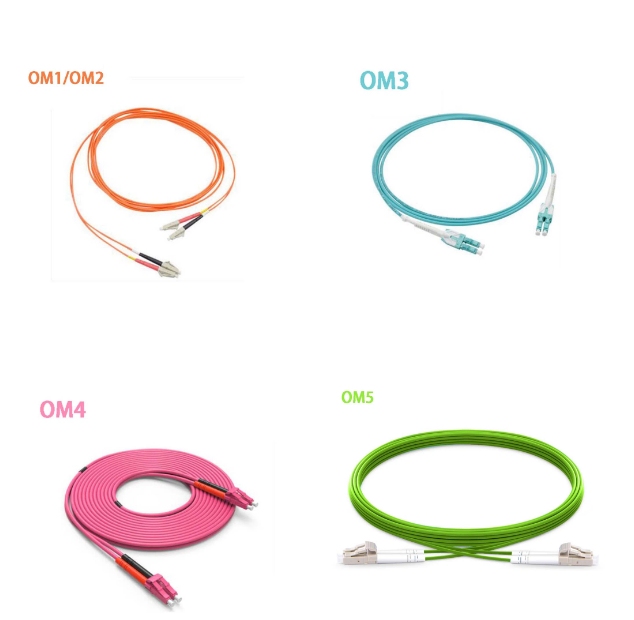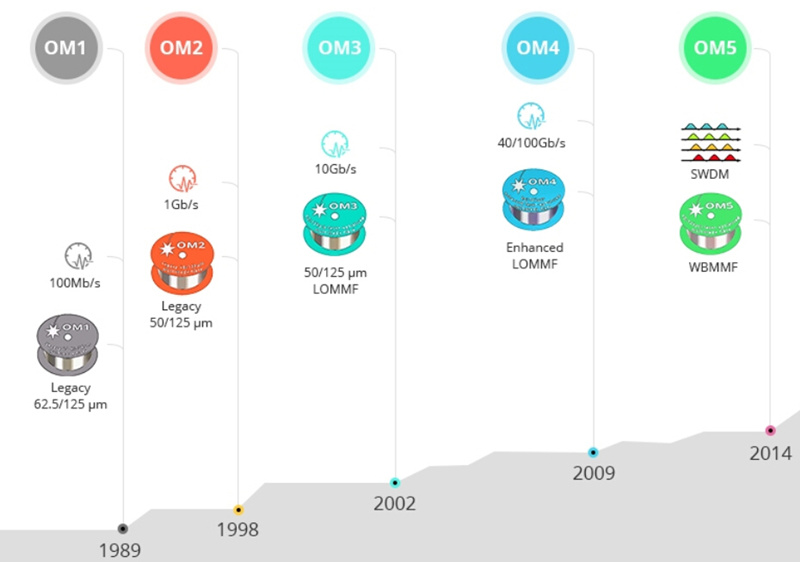

 Knowledge Base +
Knowledge Base +  2024.01.25
2024.01.25With the growing demand for high bandwidth and high speed applications in data centers, OM5 fiber optic patch cords will become the new multimode fiber optic patch cord used for high-speed data center applications, which has attracted widespread attention in the industry. So what is the difference between it and OM3/OM4?
First of all, let's get to know OM5 fiber optic patch cords.
OM5 fiber optic patch cable was firstly called broadband multimode fiber optic patch cable, which is a new standard for fiber optic patch cable defined by TIA and IEC, with a fiber diameter of 50/125 μm, OM5 fiber optic patch cable can be used for higher bandwidth applications compared to OM3 and OM4 fiber optic patch cords.In February 2017, TIA stipulated that the identifying color of OM5 fiber optic patch cords is aqua green.
What is the difference between OM5 fiber optic patch cable and OM3/OM4 fiber optic patch cable?

Outer jacket color: Generally speaking, the outer jacket colors of OM3 and OM4 fiber optic patch cords are lake blue and purple, while the outer jacket color of OM5 fiber optic patch cords is aqua green.
Wavelength: OM5 fiber optic patch cords operate at 850/1300nm and can support at least 4 wavelengths. the usual operating wavelengths of OM3 and OM4 are 850nm and 1310nm, and the transmission distances of these multimode fiber optic patch cords are not the same in the same wavelength window.
Effective Mode Bandwidth (EMB): OM5 fiber optic patch cable has a higher breakthrough in effective mode bandwidth (EMB), it will be 850nm wavelength effective mode bandwidth (EMB) increased to 6000MHZ.km, near the 880nm wavelength is up to 8000MHZ.km, which is far more than the traditional OM3 and OM4 multimode fiber optic patch cable.
How Many Types of Multimode Fiber?
Identified by ISO 11801 standard, multimode fiber optic cables can be classified into OM1 fiber, OM2 fiber, OM3 fiber, OM4 fiber and newly released OM5 fiber. The next part will compare these fibers from the side of core size, bandwidth, data rate, distance, color and optical source in details.

OM1 Fiber
OM1 fiber typically comes with an orange jacket and have a core size of 62.5 µm. It can support 10 Gigabit Ethernet at lengths of up to 33 meters. It is most commonly used for 100 Megabit Ethernet applications. This type commonly uses a LED light source.
OM2 Fiber
Likewise, OM2 fiber also comes with an orange jacket and uses a LED light source but with a smaller core size of 50 µm. It supports up to 10 Gigabit Ethernet at lengths up to 82 meters but is more commonly used for 1 Gigabit Ethernet applications.
OM3 Fiber
OM3 fiber comes with an aqua color jacket. Like the OM2, its core size is 50 µm, but the cable is optimized for laser based equipment. OM3 supports 10 Gigabit Ethernet at lengths up to 300 meters. Besides, OM3 is able to support 40 Gigabit and 100 Gigabit Ethernet up to 100 meters, however, 10 Gigabit Ethernet is most commonly used.
OM4 Fiber
OM4 fiber is completely backwards compatible with OM3 fiber and shares the same distinctive aqua jacket. OM4 was developed specifically for VSCEL laser transmission and allows 10 Gig/s link distances of up to 550m compared to 300M with OM3. And it’s able to run 40/100GB up to 150 meters utilizing a MPO connector.
OM5 Fiber
OM5 fiber, also known as WBMMF (wideband multimode fiber), is the newest type of multimode fiber, and it is backwards compatible with OM4. It has the same core size as OM2, OM3, and OM4. The color of OM5 fiber jacket was chosen as lime green. It is designed and specified to support at least four WDM channels at a minimum speed of 28Gbps per channel through the 850-953 nm window.
The prime distinction between multimode fibers rests on physical difference. Accordingly, physical difference leads to different transmission data rate and distance. Watch the following video to learn the differences between OM1, OM2, OM3, OM4 & OM5 multimode fibers.
Physical difference mainly lies in diameter, jacket color, optical source and bandwidth, which is described in the following table.
| MMF Cable Type | Diameter | Jacket Color | Optical Source | Bandwidth |
|---|---|---|---|---|
| OM1 | 62.5/125µm | Orange | LED | 200MHz*km |
| OM2 | 50/125µm | Orange | LED | 500MHz*km |
| OM3 | 50/125µm | Aqua | VSCEL | 2000MHz*km |
| OM4 | 50/125µm | Aqua | VSCEL | 4700MHz*km |
| OM5 | 50/125µm | Lime Green | VSCEL | 28000MHz*km |
Multimode fibers are able to transmit different distance ranges at various data rate. You can choose the most suited one according to your actual application. The max multimode fiber distance comparison at different data rate is specified below.
| MMF Category | Fast Ethernet | 1GbE | 10GbE | 40GbE | 100GbE |
|---|---|---|---|---|---|
| OM1 | 2000m | 275m | 33m | / | / |
| OM2 | 2000m | 550m | 82m | / | / |
| OM3 | 2000m | / | 300m | 100m | 70m |
| OM4 | 2000m | / | 550m | 150m | 150m |
| OM5 | / | / | 550m | 150m | 150m |
If you want to know about OM3 fiber and OM4 fiber, you can pay attention to ETU-LINK to learn more about the exciting content!
What are the advantages of OM5 fiber optic patch cords?
High scalability
Lower cost
High compatibility and interoperability
Widely recognized
The launch of OM5 fiber optic patch cords has attracted widespread attention and discussion, and it will bring radical changes to data centers. It is believed that OM5 fiber optic patch cords will be widely used in the near future.
Additional Learning Hub Resources
How to choose an appropriate optical fiber jumper for the QSFP-DD 800G optical module
What is structured cabling in a network system A guide for beginners
Will single mode SFP work with multimode fiber
What is the speed of SFP+ to copper
What type of connector is SFP fiber
Subscribe to the newsletter
for all the latest updates.
2-5# Building, Tongfuyu Industrial Zone, Aiqun Road, Shiyan Street, Baoan District, Shenzhen. China
